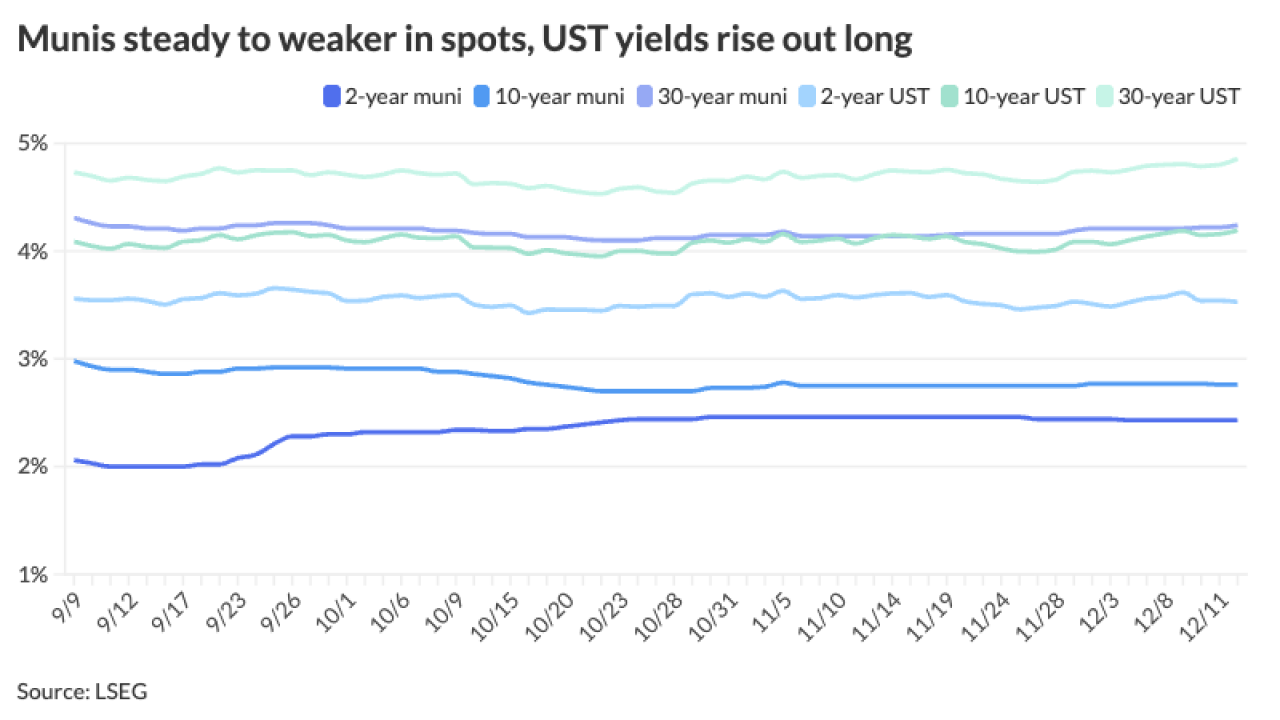Munis were steady Wednesday, ignoring a U.S. Treasury selloff as differing views on the Federal Reserve about its next move at the December meeting sent UST yields rising double-digits in spots. Equities ended mixed.
"The knee-jerk reaction of the markets to the Fed meeting (and press conference) was to sell stocks and bonds, because Chairman Jerome Powell said that an additional rate cut in December wasn't a sure thing," said Northlight Asset Management Chief Investment Officer Chris Zaccarelli.
"This is a great example of the market being forward-looking because the immediate news — a rate cut and the end of quantitative tightening (and the beginning of automatic buying of bonds) — are both positives for stocks and bonds, however, markets already expected this and were negatively surprised that future cuts might be taken off the table," he said.
This should be a buying opportunity, Zaccarelli said, "because the Fed is likely to continue to support both stock and bond markets by cutting interest rates significantly over the next 12 months (even if they do keep rates unchanged in December)."
With the Fed cutting rates by 25 basis points, past rate cuts bring to light how muni yields may perform in the near term, said Kim Olsan, senior fixed income portfolio manager at NewSquare Capital.
"Internal forces forced a stronger short-term reaction following last month's rate cut," with the five-year MMD yield selling off 17 basis points in the ensuing two weeks, and 10- and 30-year yields traded "marginally higher," she said.
"Weak fundamentals that left more sellers than buyers likely inhibited the market, as did a UST market that found itself on the back heels with tariff concerns," Olsan said.
With this rate cut, the market could likely find performance past the intermediate range, according to Olsan.
"A favorable 113 basis point slope from 10 to 20 years and another 20-basis-point pickup at the end of the curve may spur additional flows — providing enough bonds can be sourced," she said.
Twenty-year bonds have seen gains of 2.3% this month, or a full 100 basis points "excess" to a 10-year index, she said.
Conversely, given an inversion and attractive money-market yields, short-dated bonds may struggle to find any performance, Olsan said.
The two-year muni-UST ratio Wednesday was at 70%, the five-year at 65%, the 10-year at 68% and the 30-year at 91%, according to Municipal Market Data's 3 p.m. EDT read. ICE Data Services had the two-year at 69%, the five-year at 66%, the 10-year at 68% and the 30-year at 90% at a 4 p.m. read.
Muni performance in October has been strong but unexpected, as the month is usually, from a seasonal standpoint, a bit softer, said Jeff Timlin, a managing partner at Sage Advisory
"But with inflows being what they were and the pull from the Treasury market in terms of yields staying low, depending on where you are in the yield curve, that has definitely lent itself to people refocusing on fixed income," he said.
While issuance dipped this week due to the FOMC meeting, supply has remained robust, though some expect issuance to moderate for the rest of the year, Timlin said.
Money is coming into exchange-traded fund, mutual fund and separately managed account platforms, a very "diverse" inflow environment indicative of market participants' renewed focus on munis, he said.
However, the general shift in the market, in terms of what products people are using to invest in munis has favored ETFs — some firms are even converting their mutual funds into ETFs — and SMAs over mutual funds, Timlin said.
Despite this, mutual funds have seen seven straight weeks of inflows.
The Investment Company Institute Wednesday reported inflows of $1.624 billion for the week ending Oct. 22, following $918 million of inflows the previous week.
Exchange-traded funds saw inflows of $1.386 billion after $1.174 billion of inflows the week prior, per ICI data. This is the third consecutive week ETF inflows have topped $1 billion.
"People are going to utilize the product that they're most familiar with, that they probably have already, or the ones that have performed well, so the fact that [mutual funds] are receiving money in this time is not really surprising," he said, noting it would be surprising if mutual funds saw negative flows.
In a negative-return or underperforming environment, there is a structural shift in which "People are going, 'OK, what can we do on the margin? Now, when returns aren't that good,' and people have been searching for different options," Timlin said.
Due to the inflows, there are not as many bids wanteds, which are down 20% month-over-month, he noted.
"That tells you that despite this elevated supply that's coming in October, it's been taken down very easily," he said. A handful of deals struggled to get done, but the majority were well oversubscribed, Timlin said.
"What that's indirectly telling us is that there was plenty of cash there to get invested. People were buying duration, so they weren't really swapping out of things. And what they were swapping out of was high quality," he said.
In the primary market Wednesday, BofA Securities priced for the Harris County Cultural Education Facilities Finance Corp., Texas, $500 million of Houston Methodist revenue bonds. The first tranche, $175 million of Series 2025A, saw 3.8s of 12/2060 price at par.
The second tranche, $150 million of Series 2025B, saw 3.8s of 12/2060 price at par.
The third tranche, $175 million of Series 2025C bonds, saw 3.4s of 12/2060 price at par.
In the competitive market, Florence, South Carolina, (Aa2/AA-//) sold $143.645 million of combined waterworks and sewerage system capital improvement revenue bonds, to BofA Securities, with 5s of 9/2028 at 2.52%, 5s of 2030 at 2.46%, 5s of 2035 at 2.81%, 5s of 2040 at 3.41%, 4s of 2045 at 4.16%, 4s of 2050 at 4.36%, and 4s of 2055 at 4.43%, callable 9/1/2035.
AAA scales
MMD's scale was unchanged: 2.53% in 2026 and 2.44% in 2027. The five-year was 2.36%, the 10-year was 2.70% and the 30-year was 4.12% at 3 p.m.
The ICE AAA yield curve was little changed: 2.50% (unch) in 2026 and 2.43% (+1) in 2027. The five-year was at 2.39% (unch), the 10-year was at 2.73% (unch) and the 30-year was at 4.08% (unch) at 4 p.m.
The S&P Global Market Intelligence municipal curve was unchanged: The one-year was at 2.52% in 2025 and 2.44% in 2026. The five-year was at 2.36%, the 10-year was at 2.71% and the 30-year yield was at 4.09% at 3 p.m.
Bloomberg BVAL was unchanged: 2.49% in 2025 and 2.44% in 2026. The five-year at 2.34%, the 10-year at 2.69% and the 30-year at 4.04% at 4 p.m.
Treasuries sold off.
The two-year UST was yielding 3.608% (+12), the three-year was at 3.610% (+11), the five-year at 3.717% (+11), the 10-year at 4.073% (+10), the 20-year at 4.59% (+7) and the 30-year at 4.609% (+7) near the close.
FOMC meeting
The Federal Open Market Committee lowered the fed funds target rate by 25 basis points to a range of 3.75% to 4%, as expected, but there were two dissents.
"The Committee is attentive to the risks to both sides of its dual mandate and judges that downside risks to employment rose in recent months," the statement said.
Gov. Stephen Miran wanted a half-point cut, and Kansas City Fed President Jeffrey Schmid wanted rates held. "The latter might indicate that the hawks are becoming more assertive," said Sal Guatieri, senior economist at BMO.
The Fed said it will end quantitative tightening on Dec. 1.
While Powell has emphasized the panel is data-dependent, data has practically stopped, noted Alexandra Wilson-Elizondo, global co-CIO of multi-asset solutions at Goldman Sachs Asset Management.
The Fed responded by putting "policy on autopilot, tracking the dot plot path unless new, reliable data changes the story," she said.
The end of QT, Wilson-Elizondo said, "mostly reshapes reserves and money market plumbing and does not say much about the future path of the policy rate. "
"This is unlikely to be the final cut of the year," said Richard Flynn, managing director at Charles Schwab UK. "We see a strong probability of another 25-basis-point reduction at the Fed's next meeting on December 10."
Still, he said, the cuts "should be viewed as a strategic recalibration rather than a wholesale policy reversal. The Fed remains firmly data-driven, even as the ongoing government shutdown temporarily disrupts key economic releases."
Volatility will probably continue "given the many variables at play — labor market dynamics, inflation trends and policy uncertainty," Flynn said.
In his press conference, Powell cited data from public and private sources that suggest the outlook for inflation and labor hasn't changed since the last meeting.
"The downside risks to employment appear to have risen" recently, while inflation remains somewhat elevated but down from its highs. As such, "the balance of risks has shifted."
Powell said discussions about December were strongly varied and a rate cut "is not a foregone conclusion … far from it." He additionally noted, "policy is still modestly restrictive."
The Fed's "tone remains cautious but measured," said Daniel Siluk, head of global short duration and liquidity and portfolio manager at Janus Henderson Investors. "We view this as a benign, non-market-moving statement."
Primary to come
The Allen Independent School District, Texas, (Aaa/AAA//) is set to price Thursday $209.94 million of PSF-insured unlimited tax refunding bonds. FHN Financial.
The Colorado Housing and Finance Authority (Aaa/AAA//) is set to price $200.48 million of taxable single-family mortgage Class I bonds, 2025 Series O-1. RBC Capital Markets.
The River Islands Public Financing Authority Improvement Area No. 3, California, is set to price $112.375 million of Community Facilities District No. 2023-1 special tax bonds. HilltopSecurities.
Competitive
California (Aa2/AA-AA/) is set to sell $360.615 million of various purpose GOs, Bid Group C, at 12:45 p.m. Thursday; $339.385 million of various purpose GOs, Bid Group B, at 11:45 a.m. Thursday; and $302.295 million of taxable various purpose GOs, Bid Group A, at 11:15 a.m. Thursday.
The Virginia Public School Authority is set to sell $104.75 million of special obligation school financing bonds at 10:45 a.m. Thursday.
Gary Siegel contributed to this story.





